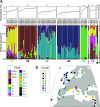Global Phylogeography of Marine Synechococcus in Coastal Areas Reveals Strong Community Shifts
- PMID: 36468851
- PMCID: PMC9765549
- DOI: 10.1128/msystems.00656-22
Global Phylogeography of Marine Synechococcus in Coastal Areas Reveals Strong Community Shifts
Abstract
Marine Synechococcus comprise a numerically and ecologically prominent phytoplankton group, playing a major role in both carbon cycling and trophic networks in all oceanic regions except in the polar oceans. Despite their high abundance in coastal areas, our knowledge of Synechococcus communities in these environments is based on only a few local studies. Here, we use the global metagenome data set of the Ocean Sampling Day (June 21st, 2014) to get a snapshot of the taxonomic composition of coastal Synechococcus communities worldwide, by recruitment on a reference database of 141 picocyanobacterial genomes, representative of the whole Prochlorococcus, Synechococcus, and Cyanobium diversity. This allowed us to unravel drastic community shifts over small to medium scale gradients of environmental factors, in particular along European coasts. The combined analysis of the phylogeography of natural populations and the thermophysiological characterization of eight strains, representative of the four major Synechococcus lineages (clades I to IV), also brought novel insights about the differential niche partitioning of clades I and IV, which most often co-dominate the Synechococcus community in cold and temperate coastal areas. Altogether, this study reveals several important characteristics and specificities of the coastal communities of Synechococcus worldwide. IMPORTANCE Synechococcus is the second most abundant phytoplanktonic organism on Earth, and its wide genetic diversity allowed it to colonize all the oceans except for polar waters, with different clades colonizing distinct oceanic niches. In recent years, the use of global metagenomics data sets has greatly improved our knowledge of "who is where" by describing the distribution of Synechococcus clades or ecotypes in the open ocean. However, little is known about the global distribution of Synechococcus ecotypes in coastal areas, where Synechococcus is often the dominant phytoplanktonic organism. Here, we leverage the global Ocean Sampling Day metagenomics data set to describe Synechococcus community composition in coastal areas worldwide, revealing striking community shifts, in particular along the coasts of Europe. As temperature appears as an important driver of the community composition, we also characterize the thermal preferenda of 8 Synechococcus strains, bringing new insights into the adaptation to temperature of the dominant Synechococcus clades.
Keywords: Ocean Sampling Day; Synechococcus; coastal areas; marine cyanobacteria; metagenomics; niche partitioning; temperature.
Conflict of interest statement
The authors declare no conflict of interest.
Figures




References
-
- Flombaum P, Gallegos JL, Gordillo RA, Rincón J, Zabala LL, Jiao N, Karl DM, Li WKW, Lomas MW, Veneziano D, Vera CS, Vrugt JA, Martiny AC. 2013. Present and future global distributions of the marine Cyanobacteria Prochlorococcus and Synechococcus. Proc Natl Acad Sci USA 110:9824–9829. doi:10.1073/pnas.1307701110. - DOI - PMC - PubMed
-
- Partensky F, Blanchot J, Vaulot D. 1999. Differential distribution and ecology of Prochlorococcus and Synechococcus in oceanic waters: a review. Bull L’institut Océanographique 19:457–475. https://www.documentation.ird.fr/hor/fdi:010019783.
-
- Paulsen ML, Doré H, Garczarek L, Seuthe L, Müller O, Sandaa R-A, Bratbak G, Larsen A. 2016. Synechococcus in the Atlantic Gateway to the Arctic Ocean. Front Mar Sci 3. doi:10.3389/fmars.2016.00191. - DOI
Publication types
MeSH terms
LinkOut - more resources
Full Text Sources
Research Materials

